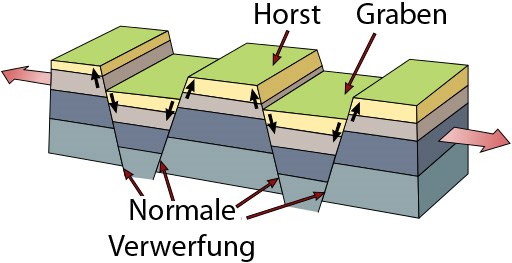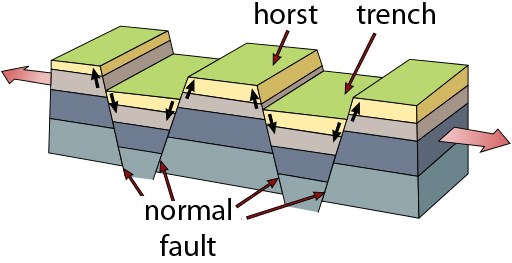Language: français | deutsch | english
français:
La citadelle, qui se trouve devant vous, était construite sur un horst de grès des Vosges du Nord. Le horst résulte d'une extension de la croûte terrestre : le bloc soulevé appartient à la portion de croûte terrestre qui est restée stationnaire ou s'est soulevée tandis que, de chaque côté, les compartiments voisins s'abaissaient (fossé).

Le grès rouge ou bigarré (appelé ici grès Vosgien), qui a été utilisé pour le mur de fondation de la citadelle est visible à certains endroits. Celui-ci peut être vu par exemple à l'emplacement de la cache ou sur les remparts de la falaise.
Bien sûr le monticule de la forteresse était déformé artificiellement pendant des années pour des besoins stratégiques, c’est pour cela que l’on peut voir le grès bigarré naturel seulement à certains points.
Le terme « grès bigarré » est dû aux diverses couleurs des pierres dont il est constitué. Il comporte une suite de pierres parfois de plusieurs centaines de mètres. On peut trouver, entres autres, des pierres de limon, de l’argile, de la chaux ou du plâtre.
À l’époque de la sédimentation du grès bigarré, il y avait un climat désertique dans notre région (il y a quelques 245 millions d’années lors du Trias). Des hautes régions environnantes, sable et argile rouges se sédimentent dans les fleuves et mers fermés. Les Dunes de sable et le limon sec fluvial se compactent finalement pour former le grès bigarré.
S'il vous plaît répondre aux questions suivantes:
1. Expliquez avec vos propres mots comment s'est formé le Horst sur lequel vous vous situez
2. Décrivez les couleurs du grès, de haut en bas.
3. Sur l'aire de stationnement (station "#Tafel"), vous trouverez un panneau d'information. Quels sont les deux années indiquées ligne 5 ?
Envoyez-moi les réponses sur mon profil ou sur sandstone@gmx.eu
Deutsch:
Die vor Euch befindliche Zitadelle wurde auf einer Buntsandstein-Horstscholle der Nordvogesen erbaut. Eine Scholle ist ein Stück Erdrinde, welche durch tektonische Bewegungen von anderen Schollen getrennt ist. Als Horst, beziehungsweise auch Horstscholle, bezeichnet man die hervorgehobene Scholle in Relation zu den benachbarten Schollen (Graben).

Der Buntsandstein, der auch für die Grundmauer der Zitadelle verwendet wurde, ist an einigen Stellen sichtbar. Diese liegen teilweise an der höchsten und härtesten Felsschicht und niedriger, wie zum Beispiel an den Bollwerken, außerhalb der Felsspitze.
Der Festungshügel wurde natürlich über die Jahre aus strategischen Gründen künstlich verformt, so dass man nur an manchen Stellen den natürlichen Buntsandstein sehen kann.
Der Begriff Buntsandstein stammt von den verschiedenen Farben der Gesteine, aus denen er aufgebaut ist und umfasst eine teils mehrere hundert Meter große Gesteinsabfolge. Diese kann aus Silt- und Tonsteinen sowie auch Kalksteinen, Gips und vielen weiteren Gesteinen aufgebaut sein.
Zu der Zeit, als sich die Sedimente des Buntsandsteins ablagerten, herrschte in unserer Region ein Wüstenklima (vor ca. 245 Mio. Jahren im Trias). Aus den umliegenden Hochgebieten lagerten sich roter Sand und Ton in Flüssen und in Binnenseen ab. Sanddünen und vertrockneter Flussschlamm verfestigten sich schließlich zum Buntsandstein.
Bitte beantwortet folgende Fragen:
1. Beschreibe mit deinen eigenen Worten die Entstehung der Scholle, auf der du dich befindest.
2. Beschreibe die Farbe des Sandsteins vor Ort, von oben nach unten.
3. Für die Anwesenheit: Am Parkplatz (Station "#Tafel") findest du eine Informationstafel zur Zitadelle,
welche zwei Jahreszahlen stehen in Zeile 5?
Sendet mir die Antworten bitte über mein Profil oder an sandstone@gmx.eu
English:
The citadel in front of you has been built on a bunter sandstone horst in the Northern Vosges. A horst is the raised fault block bounded by normal faults or graben (German for trench). A horst is formed from extension of the Earth's crust. The raised block is a portion of the crust that generally remains stationary or is uplifted while the land has dropped on either side. Horst is German for heap.

Bunter sandstone, which was also used for the foundation walls, is visible in some places. Partly they can be found at the highest and hardest layers of rock and further down, as for instance at the bulwarks outside the rock summit.
For strategic reasons the fortress mount has been shaped artificially over the years. Therefore the natural bunter sandstone can only be seen in a few places today.
The term bunter sandstone derives from the various colours of the rock it is made up from and comprises a sequence of rock strata that can be several hundred meters in depth. It is be made up from siltstone and claystone, as well as lime rock, plaster stone and many other form of rock.
At the time when deposition took place an arid climate was prevalent in this region (approx. 245 Mio years ago in the Trias). Coming from nearby highlands, sandstone and conglomerates with little clay settled in rivers and inland seas. Sand dunes and dried up stream mud finally hardened the bunter sandstone.
Please answer the following questions:
1. Describe in your own words are the emergence of the floe on which you.
2. Describe the color of the sandstone on site from top to bottom.
3. For presence: From the parking area (station "#Tafel") you will find an
information board about the citadel, which two years figures are in line 5?
Send me the answers please over my profile or to sandstone@gmx.eu
scroll up